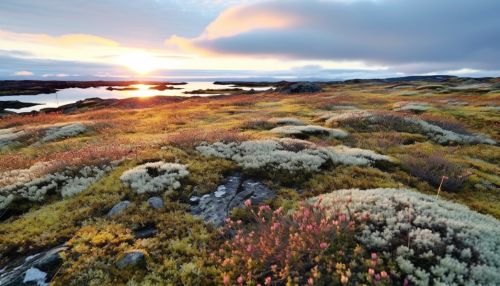Arctic ecology
Introduction
The Arctic is a polar region located at the northernmost part of the Earth. It consists of the Arctic Ocean and parts of Canada, Russia, Greenland, the United States, Norway, Sweden, Finland, and Iceland. The Arctic region is a unique area among Earth's ecosystems. The climate and environment in this region is extremely harsh and the living conditions are very difficult. The Arctic is known for its cold, desert-like conditions. The area is covered by snow and ice for most of the year, except for brief periods in summer when the snow and ice melt. Despite these conditions, the Arctic is home to a variety of flora and fauna, both terrestrial and marine.
Climate
The Arctic's climate is characterized by cold winters and cool summers. The area is known for its strong winds and low temperatures. The average temperature in winter ranges from -40 to 0 °C, and in summer from -10 to 10 °C. The region is also characterized by a phenomenon known as the midnight sun, where the sun remains visible at the local midnight. On the other hand, during the winter solstice, the sun does not rise above the horizon, leading to a period of darkness known as the polar night.
Flora
Despite the harsh conditions, a variety of plants are able to survive in the Arctic. These plants are adapted to the extreme conditions and are able to photosynthesize in the low light conditions. The flora of the Arctic includes a variety of mosses, lichens, and about 400 species of flowering plants. The most common plants are the Arctic willow, the purple saxifrage, and the Arctic poppy.


Fauna
The fauna in the Arctic is diverse and includes species that are adapted to the region's conditions. These species include marine mammals like seals, whales, and walruses, land mammals like the Arctic fox and the polar bear, and a variety of birds like the snowy owl and the puffin. The Arctic is also home to a variety of fish and invertebrates.
Human Impact
Humans have had a significant impact on the Arctic ecology. Climate change, caused by human activities, is a major threat to the region. The increase in global temperatures is causing the ice in the Arctic to melt, which is a major threat to the wildlife in the region. In addition to climate change, other human activities such as oil drilling and mining are also posing a threat to the Arctic ecology.
Conservation
Efforts are being made to conserve the Arctic and its unique ecology. Several countries have established national parks and protected areas in their parts of the Arctic. In addition, several international agreements and treaties have been signed to protect the Arctic environment and its wildlife.
